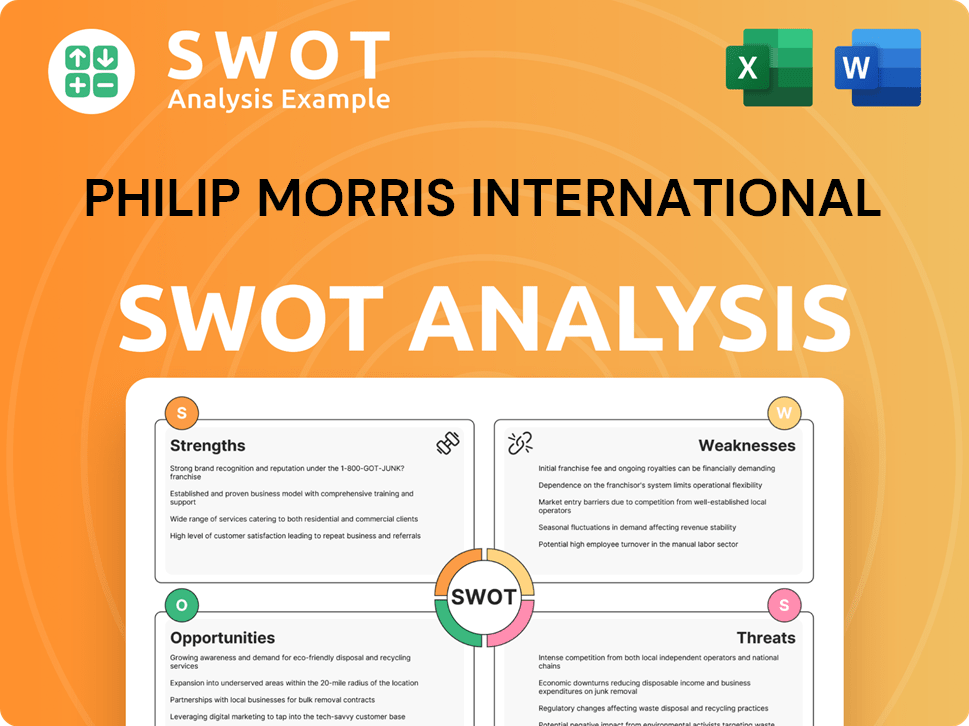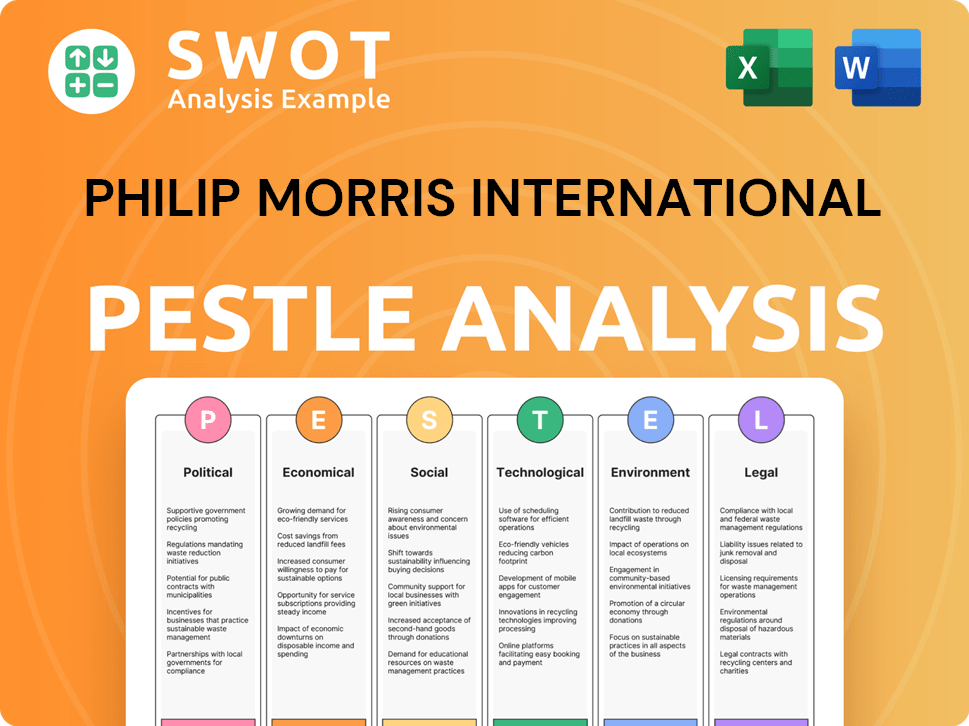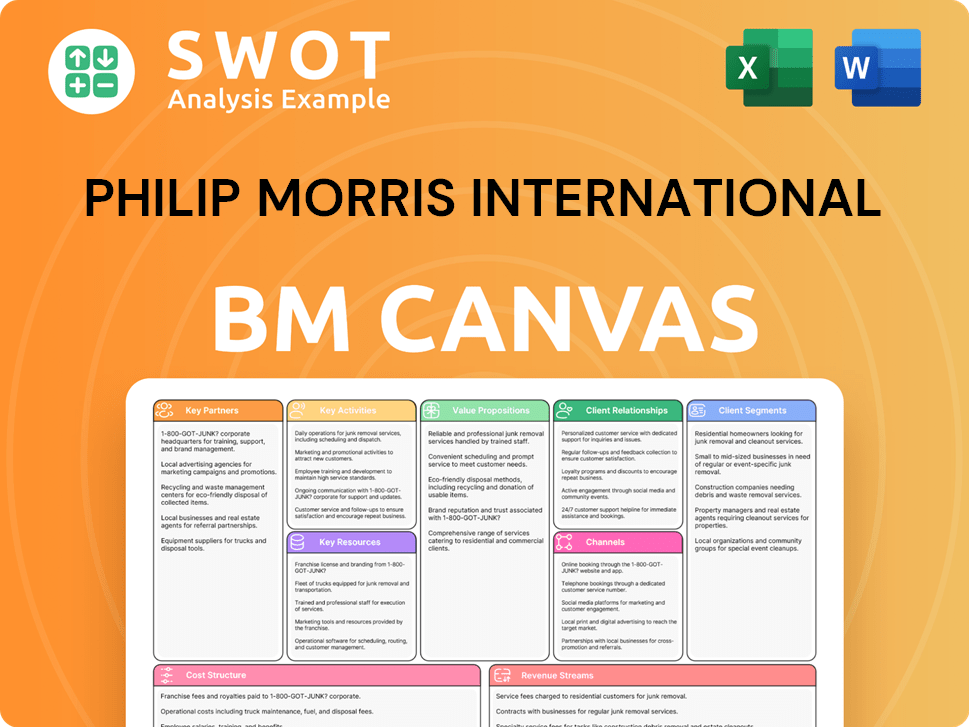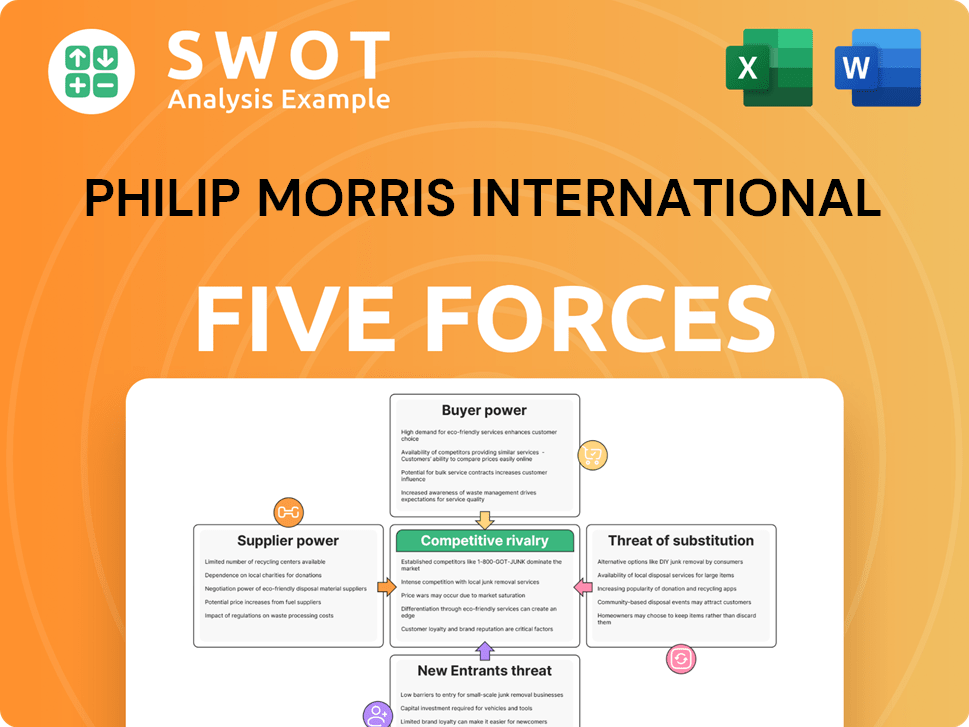Philip Morris International Bundle
Who Buys Smoke-Free Products from Philip Morris International?
Philip Morris International (PMI) is undergoing a monumental shift, moving away from its traditional cigarette roots and embracing a smoke-free future. This transformation, highlighted by the 10th anniversary of products like IQOS, VEEV, and ZYN, requires a deep understanding of its evolving customer base. This exploration delves into the Philip Morris International SWOT Analysis, and the crucial customer demographics and target markets that drive PMI's business strategy.

The company's strategic pivot necessitates a keen focus on PMI consumer behavior and market segmentation, as it caters to both traditional smokers demographics and those embracing reduced-risk alternatives. With approximately 39% of its revenue in 2024 coming from smoke-free products, understanding the specific demographics for IQOS users and the preferences of PMI's target market is more critical than ever. This shift is crucial for assessing PMI's growth trajectory and its ability to navigate the dynamic global market, including understanding the age range of Philip Morris International customers and their geographic location.
Who Are Philip Morris International’s Main Customers?
The primary customer segments for Philip Morris International (PMI) are primarily consumers (B2C). Their focus is on adult smokers, with a significant shift towards those seeking alternatives to traditional cigarettes and existing users of smoke-free products. The company's strategy centers on transitioning smokers to reduced-risk products.
PMI's target market is defined by smoking status and openness to adopting reduced-risk products. While serving a base of traditional cigarette smokers globally, PMI prioritizes transitioning these consumers to its smoke-free portfolio. This strategic shift is driven by evolving consumer preferences and the global push for harm reduction in the tobacco industry.
Key demographic characteristics for PMI's smoke-free products often include adult smokers seeking potentially less harmful alternatives. As of the end of 2024, PMI estimated that 38.6 million adults globally use its smoke-free products, with approximately 32.2 million of these being IQOS users. An estimated 72% of IQOS users have switched to IQOS and stopped smoking.
PMI segments its market based on smoking status and openness to reduced-risk products. This includes traditional cigarette smokers and those willing to switch to smoke-free alternatives. The company's focus is on converting existing smokers to its smoke-free portfolio, such as IQOS and ZYN.
The target market for smoke-free products often includes adult smokers seeking less harmful alternatives. This segment is crucial for PMI's growth strategy. The company's market research data indicates a shift in consumer preferences towards reduced-risk products, influencing their customer acquisition strategies.
Consumers are increasingly showing preferences for smoke-free products. Heated tobacco (IQOS) and oral nicotine pouches (ZYN) are key growth areas for PMI. The company's success in these segments is driven by evolving consumer behavior and a focus on harm reduction.
PMI operates globally, with its target market spread across various regions. The company's focus on smoke-free products is particularly strong in markets with favorable regulatory environments and high consumer acceptance. The geographic distribution of PMI's target audience is crucial for its market segmentation.
PMI's primary growth segment is in smoke-free products, especially heated tobacco (IQOS) and oral nicotine pouches (ZYN). In 2024, smoke-free products accounted for approximately 39% of PMI's total net revenues. This shift is a response to changing consumer preferences and a global emphasis on harm reduction.
- IQOS alone generated over $11 billion in net revenue in 2024.
- ZYN became the number one smoke-free nicotine brand in the U.S., generating close to $2 billion in net revenue in 2024.
- The acquisition of Swedish Match in 2022, a leader in oral nicotine delivery, solidified PMI's commitment to these segments.
- For more information, check out the Brief History of Philip Morris International.
Philip Morris International SWOT Analysis
- Complete SWOT Breakdown
- Fully Customizable
- Editable in Excel & Word
- Professional Formatting
- Investor-Ready Format

What Do Philip Morris International’s Customers Want?
Understanding the customer needs and preferences is crucial for the success of any business, and for it is no different. The company's customer base, which includes adult smokers and those seeking alternatives, is primarily driven by the desire for nicotine satisfaction alongside a reduced-risk profile compared to traditional cigarettes. This focus has led to significant shifts in purchasing behaviors and product preferences.
The company’s target market, including the customer demographics, is evolving. The shift towards reduced-risk products is a key trend, with a notable emphasis on the user experience, including taste, device design, and ease of use. These factors play a vital role in the adoption and continued use of smoke-free products. The company's approach to meeting these needs is multifaceted, involving continuous innovation, regulatory compliance, and targeted marketing strategies.
The company's focus on smoke-free products reflects a deep understanding of its customers' needs and preferences. By prioritizing product efficacy, user experience, and regulatory validation, the company aims to maintain and expand its market share in a rapidly changing industry. The company’s commitment to these areas is a key component of its growth strategy, as highlighted in the article Growth Strategy of Philip Morris International.
The primary need driving the company's customers is nicotine satisfaction. Customers are seeking products that offer a similar experience to smoking but with potentially reduced health risks. The adoption of heated tobacco products like IQOS is a direct response to this need.
Purchasing decisions are heavily influenced by product efficacy, perceived health benefits, and user experience. Regular, daily use is common among those who switch to smoke-free products, indicating strong brand loyalty. Taste, device design, and ease of use are critical factors.
Psychological drivers include the desire to reduce health risks and social acceptance. The ability to control nicotine consumption and the absence of ash and odor are also significant factors. These drivers influence customer choices and brand loyalty.
The company invests significantly in research and development for its smoke-free portfolio. Customer feedback and market trends directly influence product development. Innovations such as the IQOS ILUMA i devices are examples of this approach.
Marketing and product features are tailored to specific segments, emphasizing the scientific basis of smoke-free products. Regulatory validation, such as FDA authorization, is crucial for addressing customer concerns. This approach builds trust and credibility.
The company's smoke-free products often see regular, daily use, indicating a strong loyalty factor among those who successfully transition. This loyalty is a key indicator of the success of the reduced-risk product strategy. This is the key to customer demographics.
The company has invested over $14 billion in developing and commercializing smoke-free products since 2008. Approximately 72% of IQOS users are estimated to have fully switched from cigarettes. The U.S. Food and Drug Administration (FDA) has authorized the marketing of certain IQOS devices and consumables, as well as ZYN nicotine pouches, as Modified Risk Tobacco Products (MRTPs). These data points highlight the company’s investment and the impact of its product strategy.
- The company's focus on reduced-risk products is a key driver for its target market.
- Product efficacy, user experience, and regulatory validation are critical for customer adoption.
- Continuous investment in research and development supports innovation and product improvement.
- Marketing strategies are tailored to specific segments, emphasizing scientific substantiation.
Philip Morris International PESTLE Analysis
- Covers All 6 PESTLE Categories
- No Research Needed – Save Hours of Work
- Built by Experts, Trusted by Consultants
- Instant Download, Ready to Use
- 100% Editable, Fully Customizable

Where does Philip Morris International operate?
Philip Morris International (PMI) has a significant global footprint, selling its products in approximately 170 countries. This extensive reach is a cornerstone of its business strategy, enabling it to cater to diverse consumer markets worldwide. The company's geographical segmentation is key to understanding its market approach, with each region presenting unique opportunities and challenges.
PMI's operations are strategically divided into four key geographical segments: Europe; South and Southeast Asia, Commonwealth of Independent States, Middle East, and Africa (SSEA, CIS & MEA); East Asia, Australia, and PMI Global Travel Retail (EA, AU & PMI GTR); and the Americas. This structure allows PMI to tailor its product offerings and marketing strategies to specific regional preferences and regulatory environments. Understanding the nuances of each market segment is crucial for analyzing PMI's overall performance and future growth prospects.
Europe was PMI's largest revenue generator in fiscal year 2024, contributing $15.36 billion, which represents 40.54% of its total revenue. Other significant markets include Japan, which generated $4.10 billion in revenue in 2024, and the SSEA, CIS & MEA region, which brought in $11.26 billion. These figures highlight the importance of geographical diversification for PMI, mitigating risks and capitalizing on varied consumer behaviors across different regions. For more information, you can read about Owners & Shareholders of Philip Morris International.
PMI's primary market segments are Europe, SSEA, CIS & MEA, East Asia, Australia, and the Americas. Each segment is further refined based on consumer demographics and preferences. The company's strategy involves adapting its product portfolio and marketing efforts to suit the specific needs of each region.
PMI operates in approximately 170 countries, with a strong market share in around 100 countries. This extensive presence allows PMI to capture a significant portion of the global tobacco and nicotine market. This wide reach is a key factor in PMI's ability to maintain and expand its market share.
In Japan, the heated tobacco category, led by IQOS, accounted for 47% of the total industry on an offtake basis at the end of 2024. IQOS HTU adjusted market share in Japan increased by 3.1 percentage points to 30.6% in the fourth quarter of 2024. This demonstrates the strong consumer acceptance of PMI's reduced-risk products.
In Europe, IQOS HTU adjusted market share increased by 0.9 percentage points to 10.6% in the fourth quarter of 2024. Significant growth was observed in markets like Spain, Bulgaria, Romania, Greece, and Germany. This expansion highlights the increasing demand for smoke-free alternatives.
PMI's customer demographics and preferences vary significantly across regions, influencing its localized strategies. For instance, in Japan, the focus is on heated tobacco products. In Europe, PMI is expanding its presence of heated tobacco products and oral nicotine pouches.
PMI is expanding its oral nicotine pouches to 37 markets globally. The company also reacquired the commercialization rights for IQOS in the U.S. from Altria Group, Inc., effective May 1, 2024, to control its distribution in the U.S. market. This expansion strategy is crucial.
In 2023, PMI acquired Swedish Match, which brought the leading Zyn oral nicotine pouch brand into its portfolio. This acquisition strengthened PMI's position in the reduced-risk products market. This strategic move has broadened PMI's product offerings.
PMI plans to rename its 'PMI Duty Free' business to 'PMI Global Travel Retail' in 2025, reflecting a broader focus on global travel retail opportunities. This strategic shift aims to capitalize on the increasing demand in the travel retail sector. This renaming will help PMI.
PMI saw significant growth in oral nicotine pouches, with ZYN's U.S. shipments surpassing 200 million cans in 2024. This growth highlights the consumer shift towards smoke-free alternatives. This data reflects the growing popularity.
The geographic and product diversity contributes significantly to PMI's growth, helping to offset declines in traditional combustible products. This diversification strategy is essential for PMI's long-term sustainability. This helps the company.
Philip Morris International Business Model Canvas
- Complete 9-Block Business Model Canvas
- Effortlessly Communicate Your Business Strategy
- Investor-Ready BMC Format
- 100% Editable and Customizable
- Clear and Structured Layout

How Does Philip Morris International Win & Keep Customers?
Philip Morris International (PMI) focuses on attracting and keeping customers, especially by shifting adult smokers to its smoke-free products. This involves using various marketing methods, sales tactics, and product innovation. They aim to highlight the scientific evidence and perceived benefits of products like IQOS and ZYN to encourage users to switch from traditional cigarettes.
Marketing includes digital platforms, direct-to-consumer engagement, and physical retail locations. PMI also uses its investor relations mobile app, suggesting a digital-first approach for both investors and potentially consumers. The company is expanding the availability of its smoke-free products, which are now in 95 markets globally. By the end of 2024, it reached an estimated 38.6 million adult users, making it a key driver of customer acquisition.
Sales strategies are tailored to different markets and consumer preferences. For example, in Japan, where heated tobacco products are well-established, PMI has seen significant market share growth for IQOS. The company also uses its existing global network and premium cigarette brands like Marlboro to maintain a competitive position in combustible tobacco. This helps fund the transition to smoke-free alternatives. If you want to learn more, you can read about the Growth Strategy of Philip Morris International.
PMI utilizes diverse marketing channels to reach its target market. These include digital platforms with a strong emphasis on direct-to-consumer engagement. Traditional retail presence also plays a role in customer acquisition. The investor relations mobile application also provides access to company information, suggesting a digital-first approach.
Sales tactics are adapted to specific market regulations and consumer preferences. In markets like Japan, where heated tobacco is popular, PMI has increased IQOS market share. The company leverages its global network and brands like Marlboro to maintain a competitive edge in combustible tobacco. This supports the transition to smoke-free alternatives.
Retention strategies for smoke-free products are built on product innovation and the ongoing development of new generations of devices and consumables. The continuous improvement of products like IQOS ILUMA i, which fueled growth in Japan, helps maintain user engagement and loyalty.
Customer data and segmentation are crucial for effective targeting. PMI's ability to track sales and user numbers for smoke-free products suggests sophisticated data analysis. For example, the estimated number of IQOS users increased by 3.4 million in 2024 to reach 32.2 million, with 72% having switched from smoking.
PMI's target market includes adult smokers looking for alternatives. The company focuses on consumers who are open to adopting reduced-risk products. PMI aims to understand the preferences of its target market through market research.
The demographics of smokers are diverse, including various age ranges, education levels, and income levels. PMI's market segmentation considers these factors to tailor its marketing efforts. Gender distribution is also a factor in PMI's customer base.
Specific demographics for IQOS users are critical. The company tracks user numbers and in-market sales to understand its customer base. The geographic location of PMI's target audience is also considered in its strategy.
PMI segments its market based on consumer behavior and preferences. This includes understanding the customer lifestyle analysis. How PMI attracts its target market involves various marketing and sales strategies.
PMI's customer acquisition strategies focus on attracting adult smokers to smoke-free products. This includes highlighting the benefits of reduced-risk products. The company uses both digital and traditional retail channels.
PMI analyzes consumer behavior to understand preferences and needs. This helps in tailoring marketing campaigns effectively. By understanding PMI consumer behavior, the company can improve customer lifetime value.
Philip Morris International Porter's Five Forces Analysis
- Covers All 5 Competitive Forces in Detail
- Structured for Consultants, Students, and Founders
- 100% Editable in Microsoft Word & Excel
- Instant Digital Download – Use Immediately
- Compatible with Mac & PC – Fully Unlocked

Related Blogs
- What are Mission Vision & Core Values of Philip Morris International Company?
- What is Competitive Landscape of Philip Morris International Company?
- What is Growth Strategy and Future Prospects of Philip Morris International Company?
- How Does Philip Morris International Company Work?
- What is Sales and Marketing Strategy of Philip Morris International Company?
- What is Brief History of Philip Morris International Company?
- Who Owns Philip Morris International Company?
Disclaimer
All information, articles, and product details provided on this website are for general informational and educational purposes only. We do not claim any ownership over, nor do we intend to infringe upon, any trademarks, copyrights, logos, brand names, or other intellectual property mentioned or depicted on this site. Such intellectual property remains the property of its respective owners, and any references here are made solely for identification or informational purposes, without implying any affiliation, endorsement, or partnership.
We make no representations or warranties, express or implied, regarding the accuracy, completeness, or suitability of any content or products presented. Nothing on this website should be construed as legal, tax, investment, financial, medical, or other professional advice. In addition, no part of this site—including articles or product references—constitutes a solicitation, recommendation, endorsement, advertisement, or offer to buy or sell any securities, franchises, or other financial instruments, particularly in jurisdictions where such activity would be unlawful.
All content is of a general nature and may not address the specific circumstances of any individual or entity. It is not a substitute for professional advice or services. Any actions you take based on the information provided here are strictly at your own risk. You accept full responsibility for any decisions or outcomes arising from your use of this website and agree to release us from any liability in connection with your use of, or reliance upon, the content or products found herein.